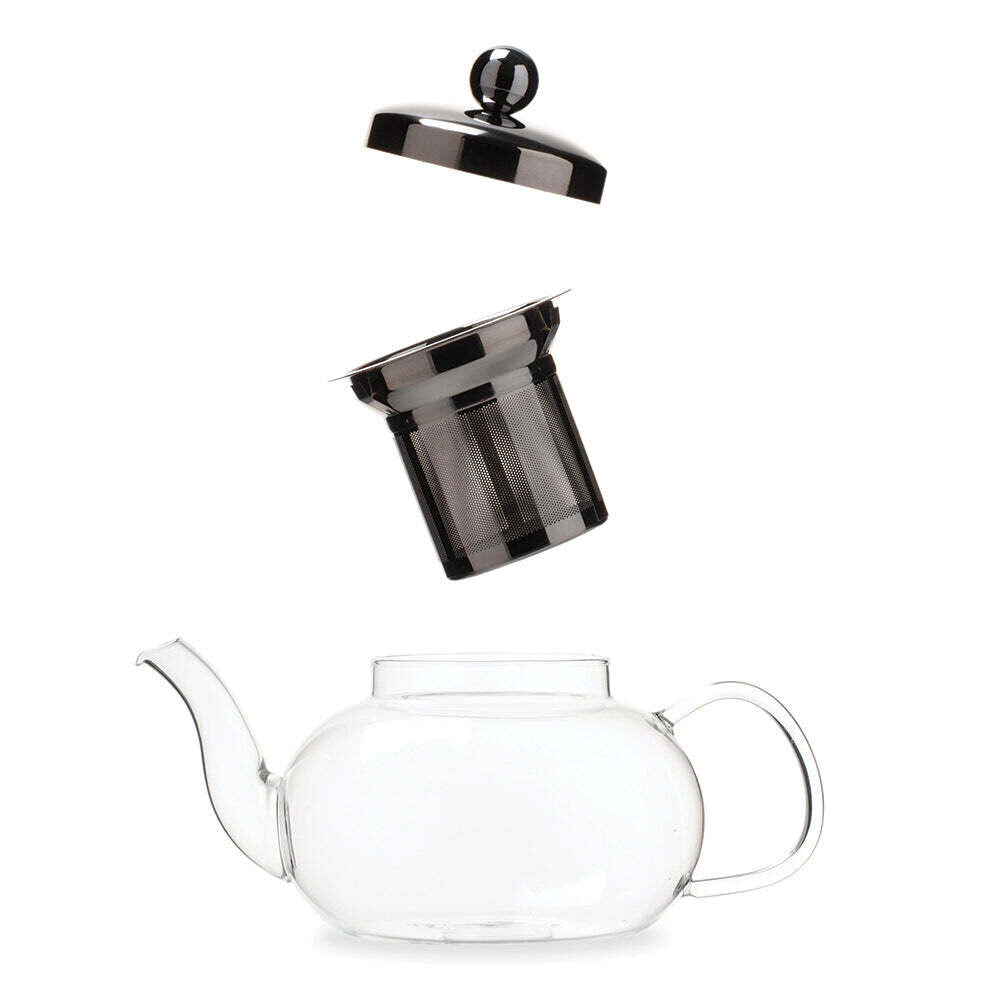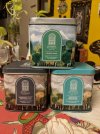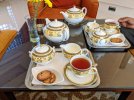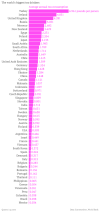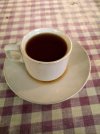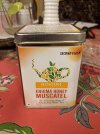An interesting long read review of a book on the fraught history of tea.
Empire of Tea: The Asian Leaf that Conquered the World
by
Markman Ellis,
Richard Coulton and
Matthew Mauger.
Reaktion, 326 pp., £25, May 2015, 978 1 78023 440 3
During the four centuries of its presence in British life, tea has made the transition from the exotically novel to the domestically ordinary, from a drug with possibly potent psychoactive powers to the mere ‘cup that cheers’, from a focus of social ritual to a casually taken and often solitary drink, from control by a quasi-state monopoly to a series of branded products largely dominated by multinational firms, from an artisanal to an industrial product. The idea of tea was once tightly linked to the idea of China; by the 18th century, its consumption was coming to be identified with the idea of Britishness. In 1863, the Birmingham grocer whose son founded the Typhoo brand boasted that ‘the great Anglo-Saxon race are essentially a tea-drinking people’. Tea was once a luxury reserved for the elite, then – mainly through changes in the management of trade and taxation – it became the most democratic of drinks. Centre stage in scenes of social intimacy, tea was also for centuries a focus of political economy, the conduct of government and the practice of international relations.
During these transformations, tea has retained distinct identities: it’s a botanically specific plant (Camellia sinensis), a desiccated product manufactured from the leaves of that plant, a drink made by infusing the dried leaves in hot water or an occasion of its consumption – a drink taken by almost everyone but that still has powers of regional and class distinction. There’s ‘afternoon tea’, ‘cream tea’, ‘high tea’ or ‘tea’ as the evening meal; bags v. loose, ‘builder’s tea’ with three sugars in a mug v. weak Earl Grey in ‘Royal Doulton with the hand-painted periwinkles’. The giving of tea can be an emotional gesture (‘tea and sympathy’). Tea-taking in its various modes is still – as cigarettes once were – a prop for playing the role of oneself or for playing one’s part with others.
Tea arrived in 17th-century Europe at the same time as two other important exotic drinks – coffee and chocolate – and, while their social and cultural trajectories diverged, all three shared several characteristics which Western commentators struggled for some time to understand and to normalise. They were each consumed hot (Europeans were not accustomed to taking hot drinks on a routine basis); they had an unfamiliar astringency or bitterness; and they were understood to be psychoactive and (mildly or strongly) addictive. Each was at once a new drink and a new way of being, and it was the new ways of being rather than the new chemicals contained in them that changed the culture. Each came to Europe from a different end of the earth: coffee from Arabia, chocolate from Mesoamerica, tea from China. Each travelled to Europe along channels carved out by violence and novel economic institutions; and each bitter drink cried out for sugar – and was therefore bound up with the institution of slavery.
It’s a story of great scope. The genre of ‘The Food/Drink/Condiment that Made the Modern World’ (salt, spices, maize, cod, oysters, refrigerated beef, the battery chicken, the Big Mac) has become a cliché, and many performances of this sort are shallow, overstated or merely cute. But in the right hands, telling the history of foodstuffs and foodways responds to current calls for histories of wider scope: histories of the longue durée; of global exchanges and contacts between cultures; and of the relations between human doings, things and the environment. Empire of Tea is an important example, sometimes brilliantly told, worth standing alongside Sidney Mintz’s classic Sweetness and Power(1985) as a history of modernity told through one of its consumable commodities.
When Europeans first encountered it in the early 17th century, all the tea in the world came from China and Japan (which had learned about it from China). Travellers and traders in China wanting to understand what tea was, what effects it had, and how it should be used, saw that it was highly valued; that it came in different varieties, with different characteristics and prices; that drinking tea was part of the rhythm of everyday life; that its consumption was governed by elaborate ritual; that the emperor and court indulged; that its equipage (fine porcelain pots and cups) was central to tea-ritual; and that tea was considered to have marked and pleasant psychological effects. It was a sociable drink – a mild stimulant both to the mind and to conversation. Some Europeans in China fell under its spell: they tried it and they liked it, and a few saw its potential as a profitable trade-good – something new to add to the cargos of silks, spices and porcelain carried back overland to Russia and on the ships of Dutch and English trading monopolies.
China tea, in china teapots, poured into china cups: this is still a scene of ‘blue willow’ domesticity whose original Oriental exoticism has been effectively erased from collective memory. Coffee, and the culture of the coffeehouse, attracted more comment in the decades following its introduction in the 1650s, but it was tea that won out in Britain.
* The historical trajectory of that domestication was, however, neither easy nor uncontested.
In 1660, Samuel Pepys recorded his first encounter with tea – ‘a China drink of which I never had drank before’ – though he turned out to be a coffee man. Some years later he noted that his wife was taking tea on medical advice – ‘a drink which Mr Pelling the Pottecary tells her is good for her colds and defluxions’. The Royal College of Physicians debated whether any of the exotic new hot drinks would ‘agree with the Constitutions of our English bodies’. In the 18th century, some physicians and natural philosophers continued to oppose tea on grounds of its stimulating and anti-soporific effects – William Buchan thought that tea was to be avoided in cases of melancholy and flatulence – but an expert consensus in its favour emerged. To the extent that tea was understood as a drug, it was generally judged a good one, repressing ‘vapours’, calming the ‘spirits’, making the mind ‘serene’.
The good news/bad news for tea was that it was far more expensive than coffee. What it lost in initial market share was gained in exclusivity. Its luxury status was one reason tea was embraced by courtiers and well-to-do women. You could get a cup of tea in a boisterous, all-male London coffeehouse, but by the early 18th century its natural home was the home, where its service was presided over in intimate gatherings by the ranking female. Tea was civil, sociable, polite. ‘Mother’, remarkably, served it with her own hands. While the hot water was hauled up from the kitchen by a servant, the lady of the house opened up the locked tea caddy with a key kept on her chatelaine ring; she put the leaves into the fashionably decorated porcelain or precious silver teapot; and she decanted the brewed tea into her guests’ (originally handle-less) porcelain cups (some sugar; usually no milk until the 19th century). The kit was a big part of the show. The tea set belonged to the history of fashion, but it was also an important driver of European technological and commercial innovation in the first part of the 18th century. First Meissen, then Sèvres, and then Bow and Chelsea succeeded in cracking some of the closely held secrets of Chinese porcelain, offering local supplies to satisfy a huge demand for fine, light and hard ceramic vessels that weren’t damaged by hot liquids and didn’t impart off-flavours.
The combination of fashion and femininity in early 18th-century tea culture offered masculine critics a soft target. The tea table was attacked as ‘the seat of female empire, as the source of gossip, the place that manufactures scandal, slander, falsehoods and lies’. Even Dr Johnson – who enjoyed his tea very much – acknowledged that sociable tea-taking might be ‘a pretence for assembling to prattle’. Women were prone to prattling and gossip, but ‘effeminate’ men could do it too. And the tea table was that sort of place – approved as a polite gathering point for the sexes and criticised as a centre of trivial and scandalous jabber.
Tea moved down the social scale through the 18th and 19th centuries. Engels’s survey of the condition of the English working classes in 1844 noted that tea was regarded ‘as quite as indispensable as coffee in Germany, and where no tea is used, the bitterest poverty reigns’. Domestic servants got a taste for it, often extracting a bit of flavour from upstairs’s dregs, and ‘common maidservants’ made the supply of tea twice a day part of their contractual agreements. Tea for the lower orders had its defenders, but the criticisms took on an edge. Tea and the coarse brown sugar that went with it were imprudent luxuries, and 19th-century philanthropists and social reformers worried that the common people were spending somewhere between 5 and 20 per cent of their income on this ‘hurtful narcotic’, not including the cost of fuel for boiling the water.
The common people’s addiction to this alien Oriental drink was squeezing out healthier fare from their diet: they should eat bread and drink wholesome English ale. To William Cobbett in the 1820s, tea was an indecent luxury, a cause of weak bodies and bad morals. ‘The practice of tea drinking must render the frame feeble and unfit to encounter hard labour ... Hence succeeds a softness, an effeminacy, a seeking for the fireside, a lurking in the bed, and, in short, all the characteristics of idleness, for which, in this case, a real want of strength furnishes an apology.’ Tea ‘corrupts boys as soon as they are able to move from home, and does little less for the girls, to whom the gossip of the tea table is no bad preparatory school for the brothel’. No rational person could refrain from ‘cursing the day in which tea was introduced into England’.
If the British lower orders were pathologically addicted to tea, so was the state that governed them. Until the 1830s, the importing of tea was a state-licensed and state-controlled monopoly, granted to the British East India Company, which also held a virtual monopoly on the global trade in Chinese tea. It was subject to customs taxes on landing at London and to excise taxes when released to merchants from the Company’s bonded warehouses. Government wanted to set the excise high enough to generate revenue but not so high that it would discourage consumption or encourage smuggling. In the middle of the 18th century, taxes effectively doubled the retail price of tea. Government ‘gaugers’ were sent out across the country to assay stocks held by merchants, to audit their books, and to seize tea smuggled from France, Denmark, Sweden and the Netherlands into unguarded ports, especially in Scotland and the north-east of England. Tax was being illegally avoided by smuggling tea into Boston, Lincolnshire, many years before legally taxed tea was dumped into the harbour of Boston, Massachusetts. A lot of the smuggled tea made its way to London, huge profits being made if the contraband could be laundered as legitimately taxed tea.
Contraband tea was much cheaper, not just because of tax-avoidance but because it could be sold directly to retailers or even consumers, eliminating the take from middlemen in the legal supply chain. Feeding the British black market was a major inducement to the proliferation of Continental and Scandinavian companies trading with China. The illegal trade in untaxed tea was enormous: in the mid-18thcentury, it was estimated that three million pounds were being smuggled every year. Excise officers were attacked and smugglers were popular figures, celebrated (in Eric Hobsbawm’s term) as ‘social bandits’. A government inquiry of 1733 reported that 250 excise officers investigating tea running had been beaten up and six had been murdered. To combat the smugglers, swathes of rural Britain were militarised, and informers were recruited and rewarded. In the south of England, there were mass executions of tea runners, whose bodies were left to rot in public view. The excise rate on tea was a political football throughout the 18thcentury and even after the debacle in the American colonies. Tea taxes were radically reduced in the mid-1740s and again in the 1780s: smuggling was effectively eliminated and tea sales exploded.
But the tea still came from China, and the Chinese required that it be paid for in silver bullion. One of the long-standing mercantilist criticisms of British tea-addiction was its drain on the Exchequer, since silver was the only commodity the Chinese wanted from Britain. There were two possible solutions to the problem: to redress the balance of trade with China or to get tea from somewhere that Britain controlled. From the 1770s, opium was grown on plantations in British India and auctioned to ‘independent traders’ who shipped it to China, where its sale for silver would fix the tea-trade imbalance. The ‘money laundering’ system was reckoned to be good political economy, though some British commentators had qualms. ‘It is a curious circumstance,’ the Quarterly Reviewcommented in 1836, ‘that we grow the poppy in our Indian territories to poison the people of China, in return for a wholesome beverage which they prepare, almost exclusively, for us.’ As the flow of opium vastly increased, so did Chinese alarm. The Qing emperor banned the trade, seizing and destroying millions of pounds of the drug. The British response was the gunboat diplomacy of the first Opium War (1839-42), which ended with the first of the so-called ‘unequal treaties’, restoring the opium trade and ceding Hong Kong to Britain, at a cost of 69 British and twenty thousand Chinese lives.
The other solution was to find a less obstreperous and expensive source of tea. It had long been assumed that Camellia sinensis – as the Linnaean name implied – was indigenous to southern China, but in the 1820s a variety was discovered growing naturally and abundantly in Assam, south of the Indian Himalayas. Was it the same plant? Could its leaves be processed into tea of similar quality to the Chinese product? The British formed an Assam company and manufactured some tea, but it wasn’t popular in London. Tea plants and seeds were covertly secured from China; Chinese tea workers were brought in; hybrids between Assamese and Chinese plants were produced; and conditions were found in which cultivated Indian tea bushes flourished. It took some time to get a result, but even in the 1830s the British were confident that ‘when the skill and science of the Europeans ... shall be applied to the cultivation and preparation of tea in favourable situations, the Chinese tea will soon be excelled in quality and flavour.’
The outcome was a massive reconfiguration of Indian environments and a massive transfer of populations: jungles were cleared for monocultural tea plantations and workers were recruited throughout the subcontinent to establish a tea industry in India that came almost totally to replace Britain’s reliance on China. In the 1860s, 96 per cent of British tea came from China; by 1903, it was only 10 per cent, with 59 per cent from India and 31 per cent from new plantations in Ceylon. ‘Above all,’ Ellis et al write, ‘Indian plantations made tea truly British. Finally, the tea industry assumed patterns and structures that stemmed from – rather than operating in parallel dissonance to – Britain’s own commercial history.’ Indian tea was imperial tea. ‘Without tea,’ Alan and Iris Macfarlane wrote in Green Gold: The Empire of Tea, ‘the British Empire and British industrialism could not have emerged.’
† Ellis and his co-authors do not say anything quite so stark but much in their book could be used to support a claim of this sort.
Tea in Britain now became even less expensive and even more ubiquitous. Its cheapness had something to do with Indian railroads delivering it directly to ports (no Chinese middlemen to pay), and something to do with new technology, making tea an authentically industrial product. The agricultural technology involved monoculture on an enormous scale, the rational spacing and arrangement of the bushes and, eventually, the use of fertilisers and pesticides. The human technology was the rational division of Indian workers’ labour, new forms of indentured servitude and factory-like discipline. But mechanical innovation was also part of the story, with implications for the changing nature of what was in the British tea cup. The rolling, cutting and drying of Indian tea leaves were mechanised by the 1870s, soon followed by the invention of sifting, sorting and packing machines. By the 1910s, eight thousand rolling machines had replaced the hand-labour of 1.5 million workers, and the cost of production was less than a third of what it had been before mechanisation.
The new machines changed the product, too. They oxidised the leaves more effectively, intensifying the distinctive flavour of black teas. And the so-called ‘dust’ and ‘fannings’ left over from mechanised processing were destined not for the waste bin but for cheaper blends, where they produced the darker and stronger brews that British consumers learned to link with quality. ‘Typhoo Tipps’ was ‘predominantly derived not from hand-rolled leaf-buds but from fannings, the coarse by-product of a more refined commodity’. The quick-colouring properties of dust and fannings made them even more valuable with the introduction of teabags – invented by an American in 1903 and widely adopted in Britain from the 1950s.
Changing patterns of manufacturing Anglo-Indian tea were associated with changing ways of marketing the stuff. Branded tea, sold with a personal or corporate assurance of its authenticity, went back at least to the late 18th century, but branding came into its own later, especially with the rise of Indian tea. This is where several new actors enter the story, including practical science and the legal system. Expert witnesses were summoned to testify before law courts and parliamentary select committees about adulteration. Tea for sale to the poor, and to the American market, had often been bulked up with fake materials (ash tree, sloe, plumbago and whitethorn leaves, liquorice and the like); synthetically coloured with such chemicals as ‘Prussian blue’ (a ferrocyanide dye), iron sulphate and red lead; and improved by the addition of dried sheep shit. In the 1830s, more than a million pounds of fake ‘British leaf tea’ – a fraction of the fraudulent stuff then on the market – was burned at the Excise Office Yard off Broad Street. Newspapers reported that ‘the city for nearly half a mile round was scented by the smell arising from the burning piles of sloe and other leaves forming the British tea.’ The ongoing scandal of what was really in British tea made space for scientific expertise – instruction manuals and kits for identifying adulterated goods, political regulation and legal penalties attending scientific findings – and for branded products, whose makers assured customers that the goods had been rigorously weighed and tested for purity. Branding also sought to guarantee a product with a recognisably uniform taste, from packet to packet and year to year. The role of the professional taster assumed much greater importance than it had in the past. Here the hard history of empire, capitalism and government intersected with the soft history of taste.
Ellis and his colleagues treat themselves to some concluding speculations about the future. For the traditional British, loose-leaf, brewed-in-a-pot cup of tea, the prospects are mixed-to-grim. Tea consumption is growing among the increasingly better-off populations of the Indian subcontinent but declining in the UK, and coffee – both instant and homemade espresso – is on the up. Some people see this as yet another sorry instance of Americanisation, like the teabag itself. Tea made from Camellia sinensis used to mean a lot in the US but now means little. In the States, ‘tea party’ refers either to 21st-century patriots (barking mad and nothing to do with tea) or 18th-century patriots (mad as hell at Mother Country taxes). Now 85 per cent of all tea taken in America is the iced version, but the UK is drinking more and more of the cold stuff and in Europe as a whole its consumption has tripled over the past decade.
The authors of Empire of Tea hold out two possibilities for the future of British tea. The first is a revived tea connoisseurship, following the patterns traced out by the Campaign for Real Ale and the frenzy for real, peasant-grown, master-roasted and barista-crafted coffee: organic Sumatra Ketiara – ‘rich, smoky and herbal, with flavours of dried fig’. Both in the UK and the US, there are some signs that this could happen, early glimmerings of future hordes of hedge-fund hipsters pecking at their iPhones over pots of Super Fine Tippy Golden Flowery Orange Pekoe Darjeeling. But another possibility is manifest in the box often presented to people who order ‘hot tea’ in US restaurants, displaying a bewildering array of bagged herbal concoctions, some containing no Camellialeaves and many bizarrely flavoured: cinnamon, vanilla, apricot, apple, pumpkin. The horrid Red Zinger ‘tea’ is a caffeine and Camellia-free brew of peppermint, hibiscus, orange peel, rose hips, verbena, liquorice, wild cherry bark and lemongrass. Even in the 18th century, the Chinese-derived name of tea was borrowed to refer to hot-water infusions of domestic herbs, so the rising British popularity of flavoured and herbal ‘teas’ would be another return to tradition masquerading as taste innovation. Tea would finally become thoroughly British, lacking any trace of the ‘Asian leaf that conquered the world’, and the future would be a world of ‘tea’ without tea.


